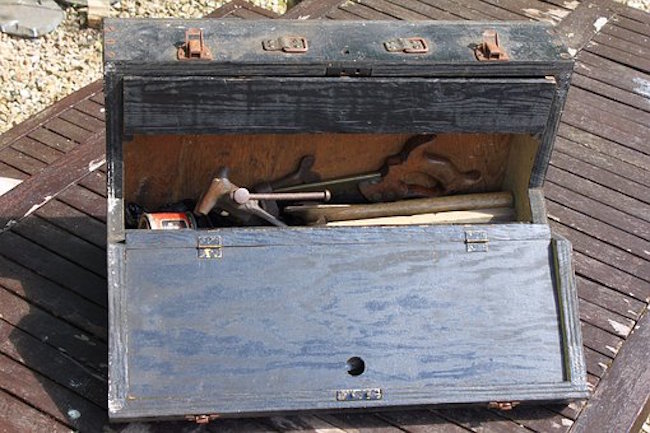My Toolbox by Richard T. for Survival Blog
I’m now 71 years old, and I have had a toolbox ever since my dad helped me build my first one when I was about 12. He cut all the parts on a homemade tablesaw that he had built out of an old washing machine motor and plywood. He showed me how to nail the parts together and paint it. It was a simple tray-style toolbox; one side had room for pliers, a hammer, screwdriver and the other side had partitions for hardware. My mother’s diary records that I liked to build things at an early age, I still do.
My folks moved from the farm to town a year before I was born. On the farm my Dad either improvised the tools he needed, paid a visit to the blacksmith shop or waited several weeks for the Sears-Roebuck catalog order to arrive. That didn’t change much in town where he had a workshop in the basement with the table saw and a wall mounted tool cabinet made out of plywood painted gray to make it look like metal. He had places in that cabinet for screwdrivers, saws, pliers, hammers, etc. He organized hardware, little brads and screws, by containing them in jars whose lids were attached to a strip of wood under a shelf and the jar contents would be accessed by twisting the jar off. This was a very common tip in 1950s and 1960s Popular Mechanics magazines.
Because I was a city boy, I bought my tools from a Sears-Roebuck store several miles away, which at that time was where you went to buy tools. And at first the only tools I needed were to work on my vehicles, therefore wrenches was all that I had. My first power tool was a Stanley 3×21 belt sander for $65 that I bought with my paperboy income when I was in high school. For many years one 16” gray metal Craftsman toolbox with a red handled tray served me well. I didn’t begin to acquire a lot of tools until my job as a cabinetmaker required that I have my own tools. Those were left at work but when we bought a house that was in need of massive restoration, I began to acquire a vast number of tools in various categories.
ORGANIZING THINGS
As I acquired more tools and toolboxes I sorely needed a system of organizing it all that could adapt to ongoing expansion. New tools coming in and defunct tools leaving can change toolbox contents either a little or sometimes quite a bit. When my plumber’s toolbox acquired new tools it split into two boxes, one for wrench projects, the other for soldering. Accommodating for the change is necessary to keep order.
By organized I don’t mean just having a place for everything and everything in it’s place; but to also know where that place happens to be. A tool that you can’t locate is a tool you can’t use, and throughout the years there have been many tools that I knew I had somewhere, but if it wasn’t where it was supposed to be, I didn’t know where that somewhere was. The only reason my tools aren’t where they belong is because I don’t return them. To correct that behavior I needed to examine why am I not returning tools to where they are supposed to be.
A big reason I don’t return a tool to the place where it belongs is simply for not having a clear idea of where it should be, and that might be because there isn’t one. Generally I organize the tools according to their function in a suitable storage system for them. There are many ways to organize tools. Given the same tools and the same toolbox options there would be as many different ways of organizing them as there would be people organizing them. And over time each one of those would evolve and change. There are more toolbox designs and toolbox organizers today than would fit in a 1950’s Sears catalog. Ammo cans, 5 gallon buckets, a kitchen drawer all serve the purpose.
KEEP BURGLARY TOOLS HIDDEN
I have the tools of a cabinetmaker, of a typical homeowner and a Saturday afternoon auto mechanic because I am all of those. I have toolbox locations for files and rasps, chisels, hammers, crowbars, screwdrivers, wrenches, sockets, wrenches and soldering tools for plumbing, firearms work, electrical, woodcarving, saws, measuring rulers & tapes, and so on. (Lest they be used against me, I don’t keep burglary tools in view, especially in the vicinity of security boxes or gun cabinets. My toolboxes of crowbars, sledge hammers, hacksaws are not kept in the house or in sight.)




